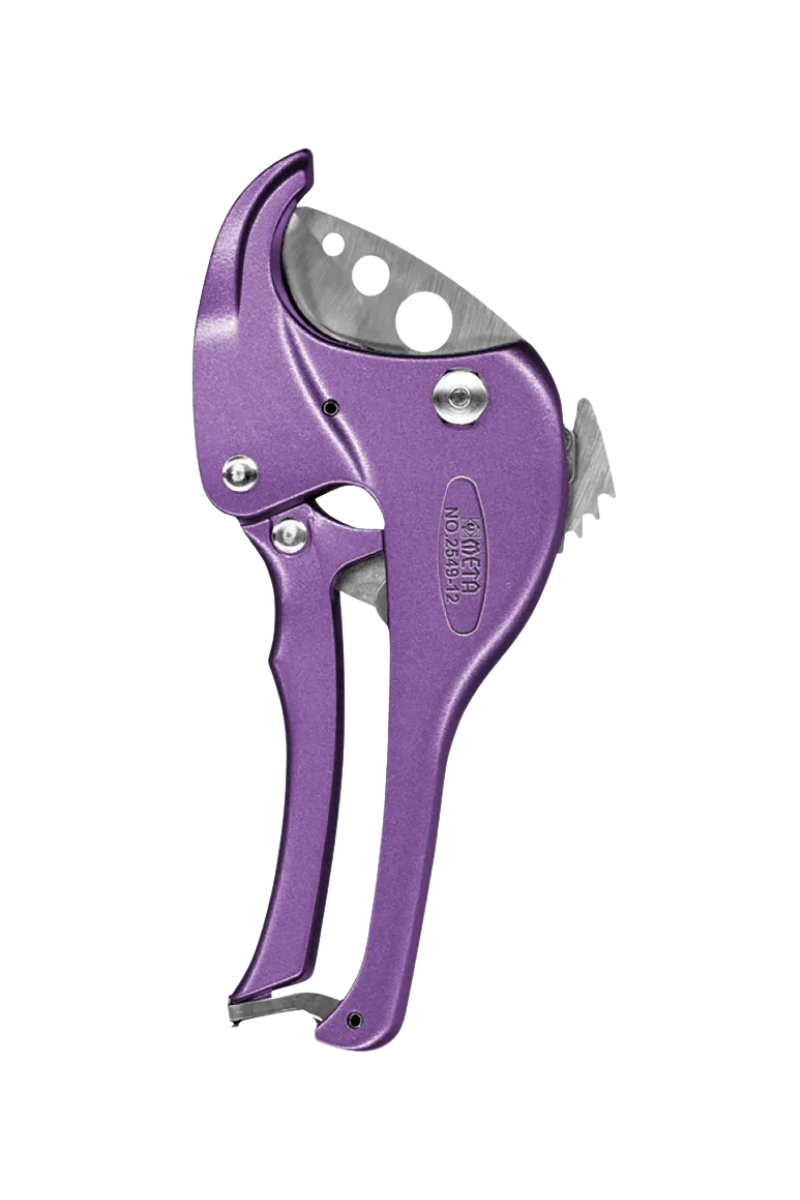Pipe Cutters: The Secret Weapon Every Tradesperson Needs
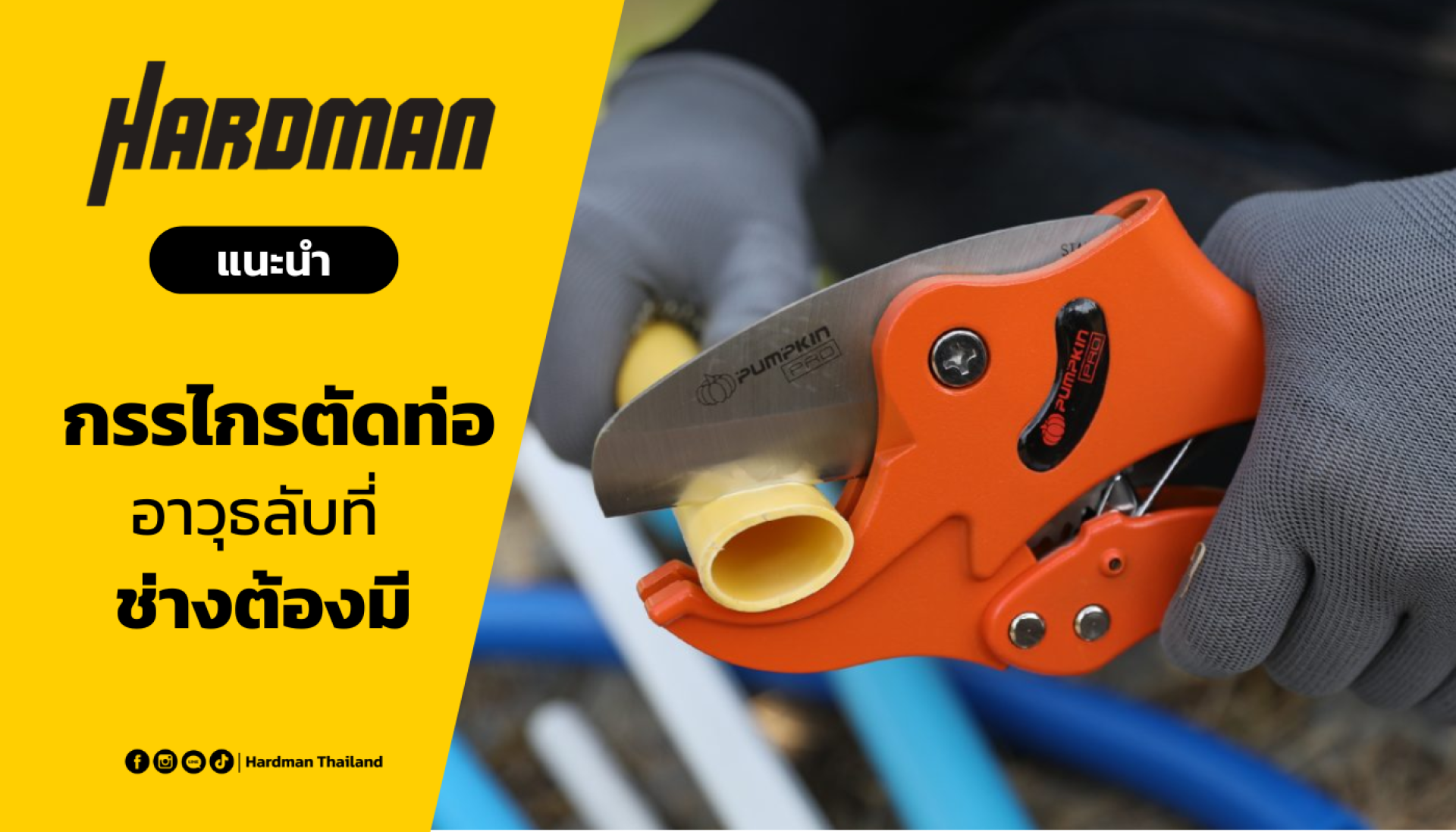
In the world of craftsmanship, whether it's building a new home, repairing leaky plumbing, or even small DIY projects involving pipes, cutting pipes to the right size with a perfect, clean edge is crucial for strong, durable, and problem-free results. A pipe cutter isn't just an ordinary hand tool; it's a "secret weapon" that helps professional tradespeople and DIY enthusiasts work quickly, precisely, and to a high standard. You won't waste time fixing leaky pipes or imperfect connections anymore.
What is a Pipe Cutter and Why is it Essential for Every Tradesperson's Toolbox
A pipe cutter doesn't look like the ordinary scissors we use to cut paper. Instead, it's specifically designed for cutting various types of pipes, including PVC, PPR, PE, or other plastic pipes widely used in plumbing, construction, or even home repair and renovation. The primary and most crucial advantage of this type of cutter is its ability to create a smooth, clean, and burr-free cut. A clean and straight cut ensures that pipe connectionswhether through gluing, heat fusion, or fitting jointsare tight and secure, effectively preventing leaks that often result from poorly cut edges.
Types of Pipe Cutters
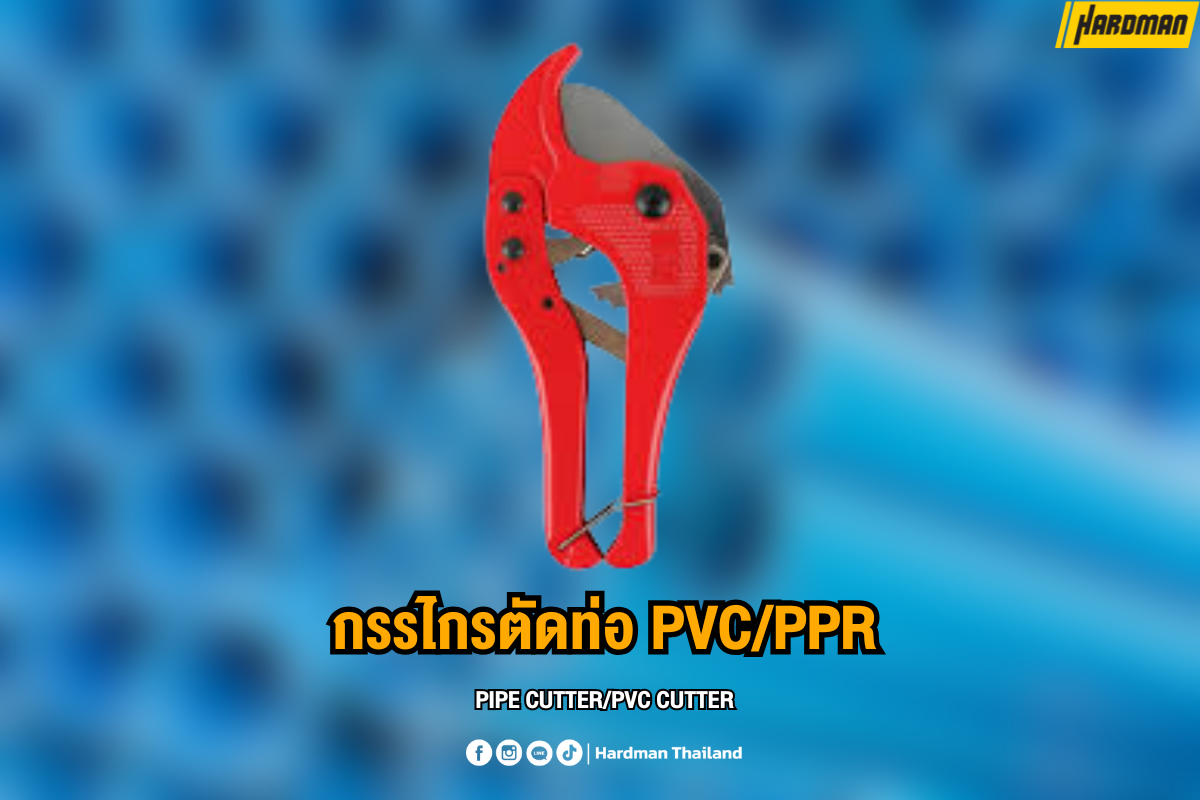
Pipe Cutter/PVC Cutter
This is the most common and widely popular type for general plumbing work. This kind of pipe cutter often comes with a ratchet mechanism, which is a gear system that greatly reduces the effort needed for cutting. This allows for easy cutting of relatively large plastic pipes without much force. The blade is typically made from high-carbon steel or stainless steel for sharpness and durability. It's suitable for small to medium-sized plastic pipes used in water supply, drainage, or even general home DIY projects. With a design focused on ease of use, it's a top choice for both professionals and beginners.
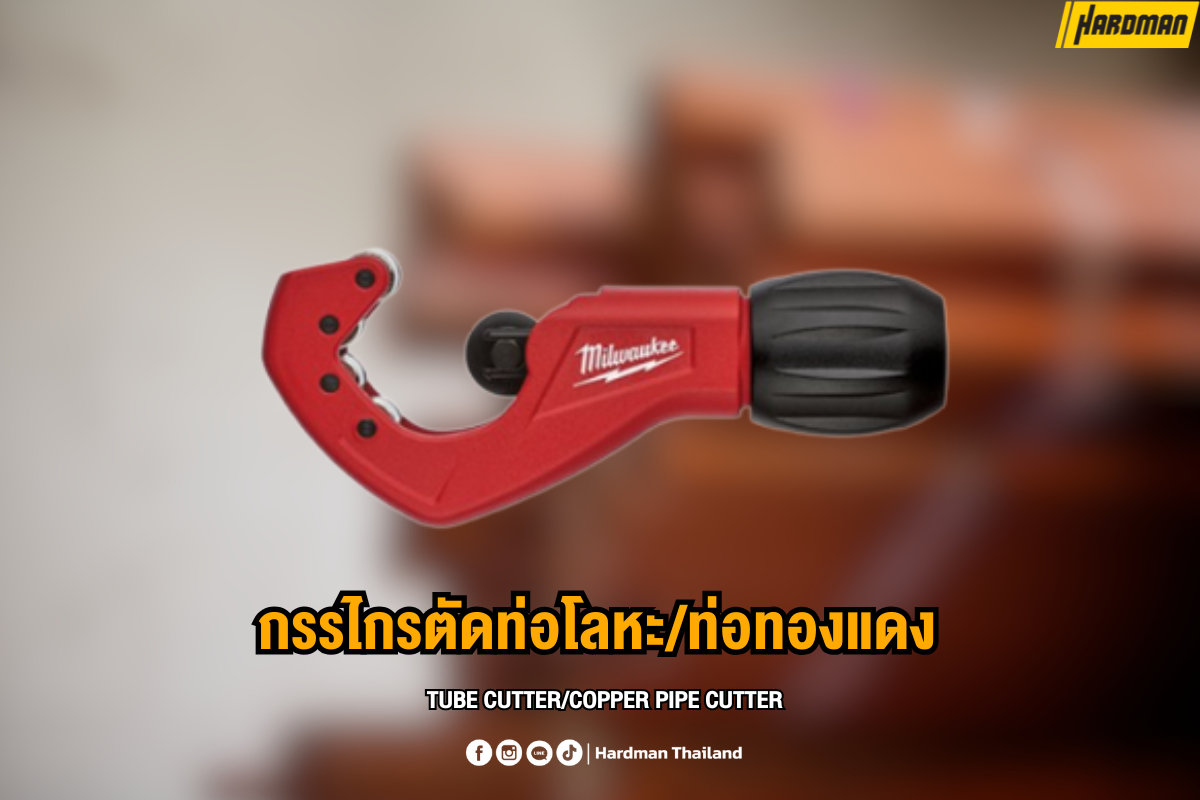
Tube Cutter/Copper Pipe Cutter
For jobs involving metal pipes, such as copper pipes, aluminum pipes, or certain types of stainless steel pipes, a metal pipe cutter is the right answer. Its key feature is a sharp, circular cutting wheel that gradually scores around the pipe, along with rollers to hold the pipe securely. The user slowly rotates the cutter around the pipe while tightening a screw to gradually press the cutting wheel into the pipe's material until it breaks cleanly. This cutting method ensures a precise cut and prevents the pipe from denting or deforming, which is extremely important for metal pipes that require tight soldering or connections.
How to Choose a Pipe Cutter
- Blade Material: This is the heart of your pipe cutter. Opt for blades made from high-quality steel like Stainless Steel for rust prevention and longevity, or SK5 high-carbon steel for exceptional hardness and sharpness. A sharp and durable blade ensures precise cuts with less effort, reducing the risk of dulling or chipping easily.
- Supported Pipe Size and Diameter: Each pipe cutter model has a different capacity for cutting pipe diameters. Check the specifications to see if the cutter can handle the sizes you regularly work with. Choosing a cutter that supports a variety of pipe sizes will save you from buying multiple tools for different jobs.
- Cutting Mechanism: For plastic pipe cutters, a ratchet mechanism is highly recommended. This mechanism significantly reduces the force needed to cut thick-walled or large-diameter pipes. You just squeeze and release in stages until the pipe is cut. The ratchet system greatly reduces effort and fatigue, especially when you have many pipes to cut.
- Handle: A good pipe cutter should have a comfortable, non-slip handle. Look for features like rubber grips or an ergonomic design. A well-designed handle will reduce fatigue during long hours of use and allow for more precise control during cutting.
- Brand and Reliability: Choosing a pipe cutter from a reputable brand with positive user reviews will give you confidence in the product's quality. Trusted brands often offer product warranties and good after-sales service.
Effective Pipe Cutter Usage
- Pipe Preparation: Before you start cutting, clean the end of the pipe to be cut, removing any dirt, dust, or residue that could result in an uneven cut. Then, clearly mark the cutting point with a pencil or marker to achieve the desired pipe length.
- Securing the Pipe: Firmly and straightly securing the pipe is crucial for achieving a perpendicular and precise cut. You can use a vice or hold the pipe tightly with your other hand. Make sure the pipe doesn't twist or move while you're cutting.
- Cutting Technique: For ratchet-style plastic pipe cutters: Position the blade exactly where you want to cut. Then, gradually apply pressure to the handles and release in a rhythmic motion. The blade will incrementally slice through the pipe until it's severed.
For metal pipe cutters: Place the blade and rollers on the pipe. Rotate the cutter around the pipe while gradually tightening the screw to press the blade into the pipe's material. Repeat this process until the pipe is cut. Apply just enough pressure; don't over-tighten, as this could dent the pipe or damage the blade. - Safety First: This is the most critical aspect. Always wear thick gloves to protect against cuts from the sharp blade, and wear safety glasses every time you use the tool to prevent pipe fragments or debris from flying into your eyes. Be especially cautious when cutting pipes that are under pressure or those that might contain chemical residues.
Maintenance and Care for Pipe Cutters
1. Immediate Cleaning After Use
- Remove Debris: After each use, use a clean, dry cloth or a small brush (like an old toothbrush) to thoroughly brush or wipe away any plastic shavings, metal fragments, or other dirt stuck on the blade and in the grooves of the cutter.
- Wipe Off Adhesives or Chemicals: If your cutter comes into contact with pipe glue or other chemicals, wipe them off immediately with a damp cloth or an appropriate cleaner that won't corrode the metal parts.
- Dry Thoroughly: After cleaning with water or cleaning solutions, make sure to dry the cutter completely, including every nook and cranny, especially metal areas, to prevent rustthe arch-nemesis of metal tools.
2. Lubrication
- Multipurpose Lubricant: Regularly apply a few drops of multipurpose lubricant (e.g., WD-40, machine oil, or tool oil) to the joints, pivot points, or the ratchet mechanism. Do this weekly or after every heavy use.
- Blade Application: You can also apply a thin layer of oil to the blade to prevent rust, especially for cutters not made of stainless steel. The oil creates a thin film that protects against moisture and air.
- Work the Mechanism: After applying lubricant, open and close the cutter several times to ensure the oil spreads evenly throughout all moving parts and joints.
3. Blade Sharpening
- Sharpening Tools: You can use a whetstone or a specialized sharpener designed for cutter blades/utility knives, which are widely available. If you're not confident sharpening it yourself, consult a professional or a sharpening service.
- Sharpening Technique: Sharpen the blade at its original angle (typically around 20-25 degrees). Sharpen consistently on both sides until you feel it's sharp.
- Frequency: Sharpening frequency depends on usage. If you use it often or cut hard materials, sharpen it more frequently. Or, observe its cutting performance: if you find yourself needing to exert more force or if the cut is no longer smooth, it's time to sharpen.
- Blade Replacement: For some pipe cutter models, especially those with a ratchet mechanism that have replaceable blades, if the blade becomes too short from sharpening or is severely damaged beyond repair, replacing the blade with a new one is the best option for optimal performance.
4. Proper Storage
- Store in a Dry Place: Avoid storing your pipe cutter in high-humidity areas, as this is the primary cause of rust.
- Use a Tool Box/Pouch: Always store your pipe cutter in a toolbox with a dedicated slot or a protective pouch designed to prevent blade impacts and protect against accidental cuts.
- Away from Chemicals: Do not store the cutter near corrosive chemicals or in areas with chemical fumes, as this can damage the cutter's materials.
- Optimal Position: Store the cutter in a closed position to protect the blade and prevent accidental injury.
- Check for Looseness: Inspect all nuts, screws, or rivets to ensure they are tight. If you find any loose ones, tighten them immediately to prevent them from coming undone during use.
- Check for Damage: Look for any cracks, chips, bends, or unusual wear on any parts, especially the blade and the working mechanism. If you find severe damage, repair or replace the part immediately.
- Test Operation: Open and close the cutter several times to check if it operates smoothly. Listen for any strange noises or feel for any sticking.
Recommended Popular PVC Pipe Cutters
1. PUMPKIN 63 mm PVC Pipe Cutter, Model 33625 / PTT-PC63
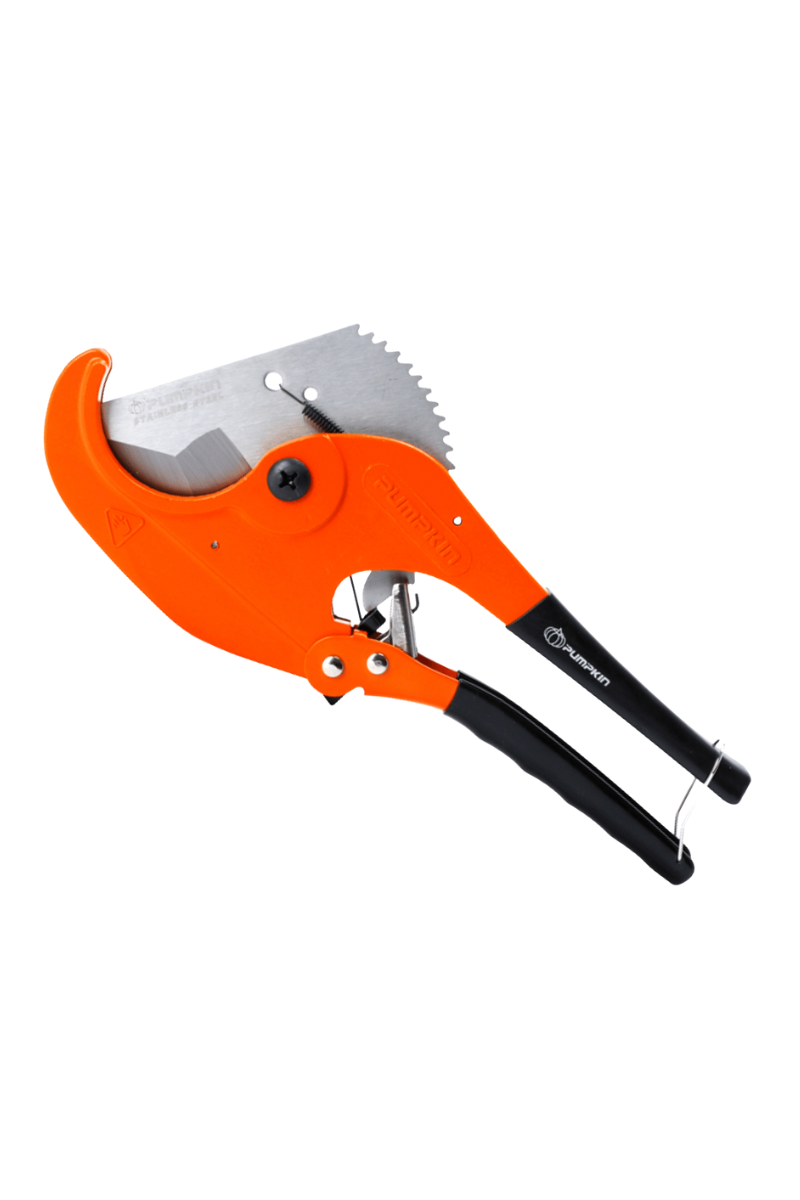 |
Key Features:
- Large Cutting Capacity: This is its most significant advantage, capable of cutting PVC, PPR, and PE pipes up to 63 mm in diameter. This makes it ideal for medium to large-scale projects or for tradespeople who encounter a wide range of pipe sizes.
- Ratchet Mechanism: Equipped with a ratchet gear system that significantly reduces the force needed for cutting. This makes cutting larger pipes much easier, requiring less effort from the user and reducing fatigue.
- High-Quality Blade: The blade is typically made from high-quality, hardened steel for superior sharpness and durability. It provides clean cuts and maintains its edge well over time.
- Ergonomic Handle: Designed for a comfortable grip, it reduces strain during continuous use.
Ideal for: Plumbers, contractors, or DIY users with larger projects who need a cutter that can handle a wide range of pipe sizes.
2. STANLEY 42 mm PVC Pipe Cutter, Model 14-442
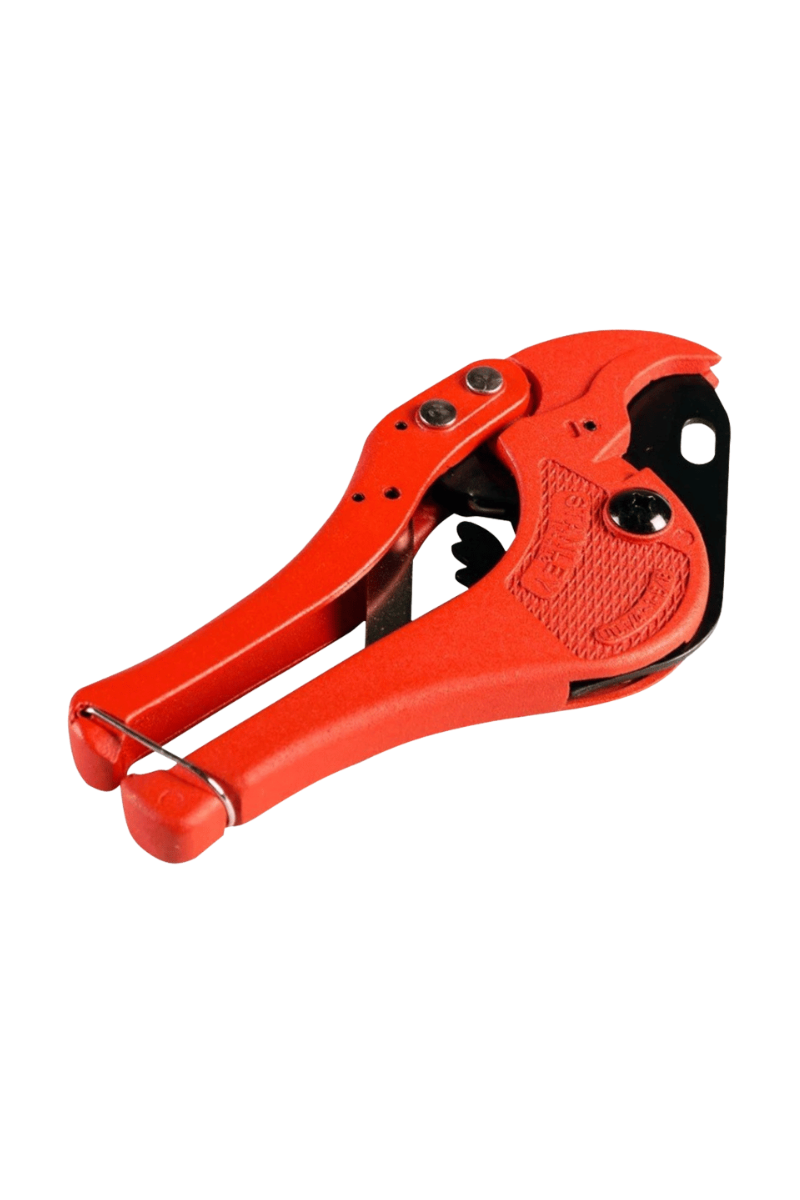 |
- Brand Reliability: Stanley is a world-renowned power tool brand, trusted for its quality and durability, ensuring high manufacturing standards.
- Robust Construction: The tool is typically made from high-quality materials, making it resistant to heavy use and impacts.
- Razor-Sharp Blade: The blade is exceptionally sharp, allowing for precise cuts, clean edges, and reduced burrs.
- Designed for Efficiency: Its cutting mechanism is engineered for maximum efficiency when cutting standard PVC pipes.
Ideal for: Professional tradespeople and DIY users who want a high-quality tool from a trusted brand for durable and precise long-term use.
3. META 42 mm PVC Pipe Cutter, Model PC-301L
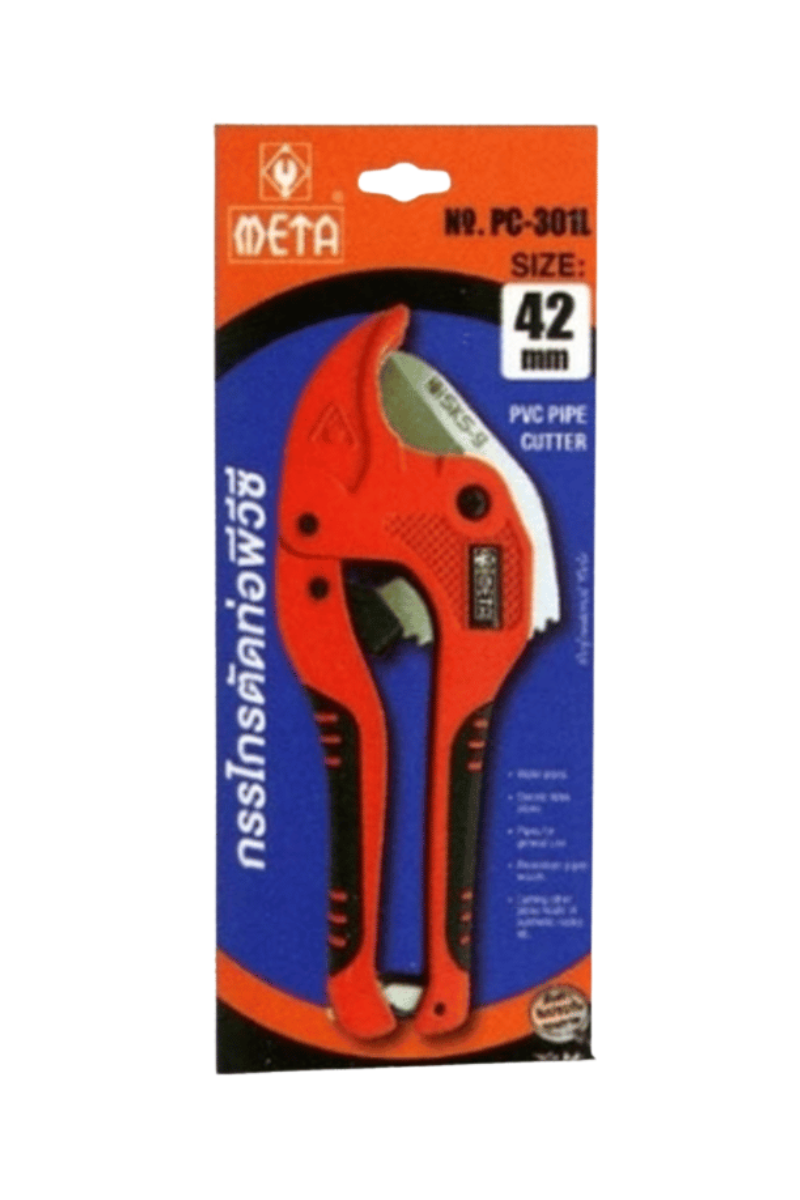 |
- Cost-Effective: This is one of its most notable advantages, offering an accessible price point that makes it ideal for beginners or those needing a backup cutter.
- Lightweight and Compact: Its suitable size and moderate weight make it convenient for carrying and using in confined spaces.
- Easy to Use: Features a straightforward cutting mechanism, allowing general users to quickly understand and operate it.
- Good Basic Performance: Despite being a budget-friendly model, it still delivers satisfactory performance for cutting standard PVC pipes.
Ideal for: General DIY users, beginners, or those needing a pipe cutter for light to medium-duty tasks who prioritize budget.
4. META 2549-12 Super Heavy Duty PVC Pipe Cutter (Purple)
Key Features:- Focus on Strength and Durability (Super Heavy Duty): The model name indicates it's built to withstand heavy and continuous use. Its overall construction is typically more robust than standard pipe cutters.
- High-Quality Materials: It's expected to be manufactured from exceptionally strong and durable materials, ensuring a long lifespan even under high pressure.
- Excellent Cutting Performance: Designed for durability, it provides stable and precise cuts, even through thick-walled pipes.
- Unique Purple Color: Its distinctive purple color makes it easy to spot in a toolbox and adds a unique touch.
Ideal for: Professional tradespeople who regularly engage in heavy-duty work, contractors, or anyone seeking an exceptionally strong and durable pipe cutter for continuous use.
5. PUMPKIN PRO PVC Pipe Cutter, Model PRO-42PVC 33610
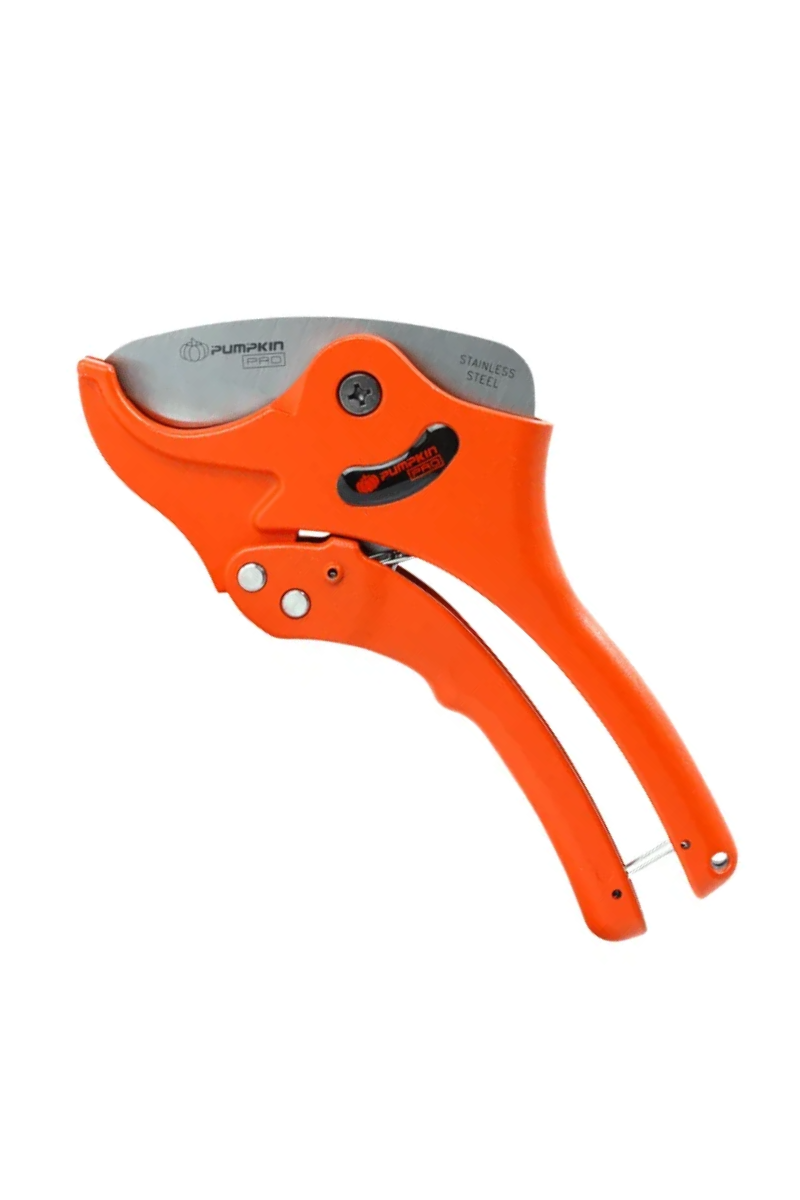 |
Key Features:
- "PRO" Series: This designation means it's designed for professional applications, often featuring improved characteristics over standard models.
- Extra-Sharp Blade: Likely equipped with a higher-quality blade, possibly with a surface coating for increased sharpness and wear resistance.
- Advanced Effort-Saving Mechanism: The ratchet system or other mechanisms may be enhanced for smoother operation and greater leverage, making it easier to cut even thick pipes.
- Ergonomic Handle: Designed for comfort, it reduces fatigue during prolonged continuous use.
Ideal for: Plumbers, contractors, or DIY users who need professional-level cutting performance for standard pipe sizes, prioritizing comfort and superior quality.
6. META (Red-Black) Pipe Cutter, No. MT-20 Model 630007
Key Features:
- Distinctive Design: Its unique red and black color scheme makes it easily recognizable and gives it a modern look.
- Good Value: META consistently provides products that offer excellent value in terms of price and basic performance.
- Lightweight and Portable: Its manageable weight makes it easy to carry around and store in a compact toolbox, ideal for mobile tasks.
- Good for General Use: It's well-suited for straightforward PVC pipe cutting tasks, providing cuts that are sufficient for general applications.
Ideal for: General DIY users, tradespeople who need a cutter for lighter duties, or anyone looking for an affordable backup pipe cutter.
7. META PVC Pipe Cutter, No. FMY-13 Model 011244
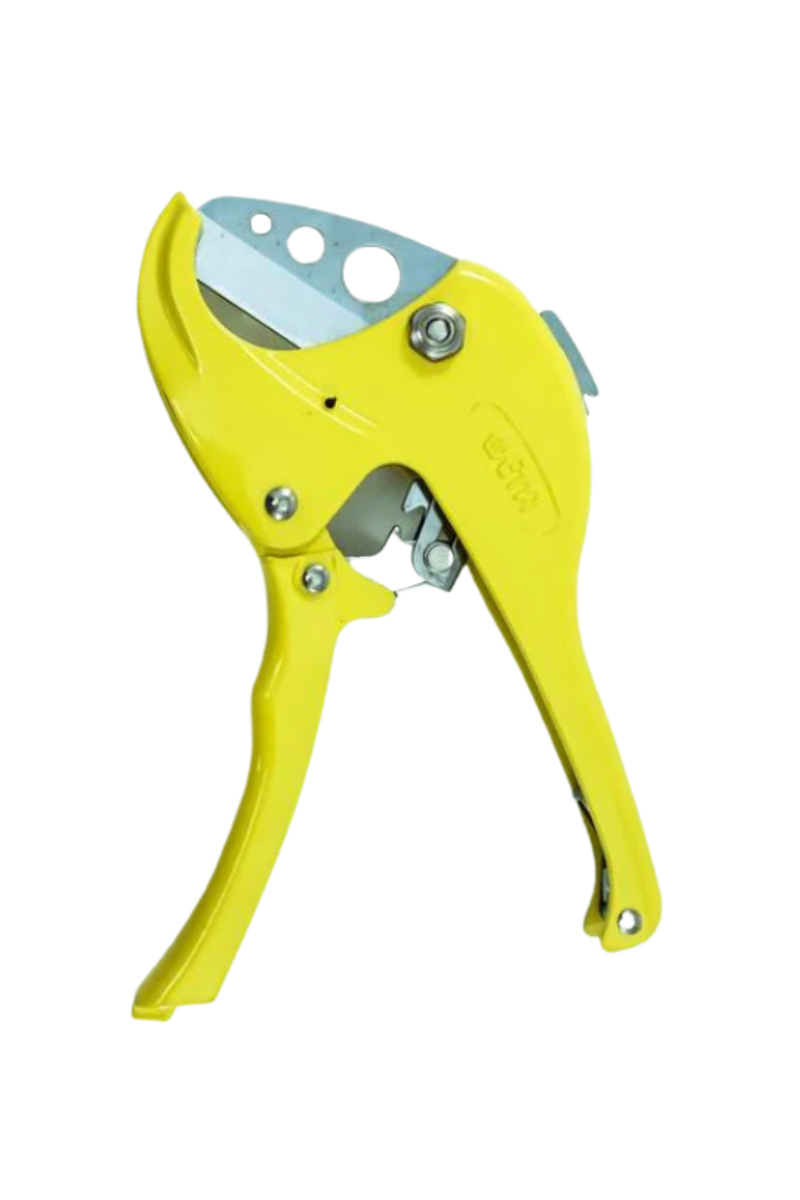 |
Key Features:
- Standard META Model: Typically provides reliable performance for general PVC pipe cutting jobs.
- Easy and Straightforward to Use: It has no complex functions, making it easy for general users to pick up and use with minimal learning.
- Economical Price: This is another cost-effective option, ideal for those on a limited budget.
- Suitable for General Tasks: Delivers clean and precise cuts, sufficient for typical home PVC pipe installations or repairs.
Ideal for: DIY users who need a basic tool for general PVC pipe cutting, or for infrequent repair tasks.
Summary: The Pipe Cutter An Indispensable Tool for Tradespeople
It's undeniable that a pipe cutter is more than just another hand tool; it's like a secret weapon that helps ensure plumbing or piping jobs are completed with the highest quality and efficiency. Whether you're a professional tradesperson regularly handling large projects or a homeowner who enjoys DIY repairs and renovations, having a good pipe cutter in your toolbox will save you time and effort, while reducing the risks associated with poor-quality pipe cuts.
Where to Purchase or Inquire About Products
For more information or to order products, visit Hardman, your comprehensive tool center, at Rama 3. Alternatively, you can send a message to their Facebook page inbox. Their team is ready to respond quickly and offers nationwide delivery
